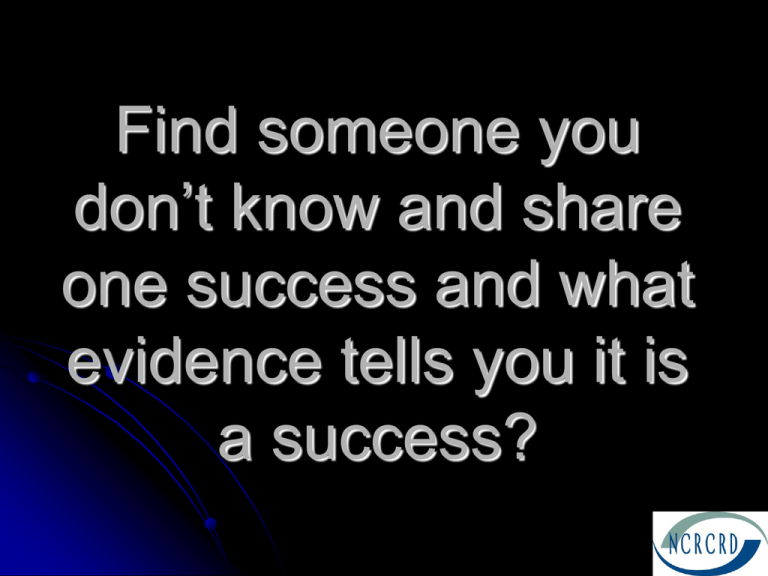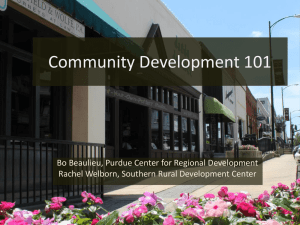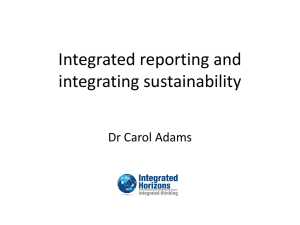Evaluation Strategies from Opening Night Survey
advertisement

Find someone you don’t know and share one success and what evidence tells you it is a success? Survey Results A sleeping giant is rising! Move outside the walls! Broke the ice! Just do it! Successes!!!!! Enhanced perception of what we do – 8 CC and extension working together - 3 Networking – 8 Strategic plan – 7 Economic development -14 Workforce development - 15 Civic engagement – 2 Meet the needs of the people - 3 Challenges!!!! Internal challenges – 27 Sustainability – 16 Economic development – 5 CC and extension working together – 3 Civic engagement – 18 Time, logistics, funding, communication, staffing, president’s role, $ Stakeholders, culture of deficit TURF - 2 We have increased the demand Community colleges and community Civic engagement – 47 Change in culture, inclusion, stakeholders Bright future – 37 Strategic plan – 2 Economic development – 8 AI High schools Community college and LGUs Resources and sustainability – 4 Change in culture Very successful, critical to success Partnerships evolving – 7, improving – 8 Share projects – 5 Personalities No more negativity Limited potential Non existent Evaluation Need to find a measure – 6 Don’t have any – 8 Things we are using: KASA, formative, paper trail Issues: wasn’t built in, staffing turnover Proof of the pudding is in the eating of it! Evaluation Processes None – 6 Improve – 1, in process -4 Focus groups – 4 Output measures – 6 Surveys 5 Documentation - 2 Benchmarks Pre/post surveys Every program, every service What should we continue to do? Guidance – 15 Support – 7 Convene us – 7 Sustainable development 4 Evaluation – 2 Onsite visits – 2 Networking – 2 Keep in touch – 2 Multi-level partnerships CHEERLEADING Impact Enhanced role of the college – 23 Good practice – 3 Economic development – 9 Increased access to education – 3 Long ways to go! What we want to tell Ford Value of partnerships – 13 Civic engagement and community building – 3 Learning together – 2 Work with extension - 2 Expanding offerings Native learners can have culture and education Struggled AI, high schools, see the potential, resources for the project were important Planning for Sustainability Mary Emery Cornelia Butler Flora North Central Regional Center for Rural Development memery@iastate.edu www.ncrcrd.iastate.edu Why do some communities thrive while in the next county over a similar community struggles to survive? What the Research Tells Us: Heartland Center for Leadership Development: 20 Clues Flora and Flora: Entrepreneurial Support Infrastructure Flora, Flora and Fey: Rural Legacy and Change (pause) Worthy Causes and Community Activities Worthy Causes and Community Activities Built Capital Financial Capital Natural Capital Political Capital Healthy Ecosystem Vital Economy Social Well-Being Cultural Capital Social Capital Human Capital Capital Resources invested to create new resources over a long time horizon Why Focus on the Capitals? Importance of place. Interdependency and interaction. Balance. Ripple effect. Natural Capital Natural capital provides possibilities and Air quality, wind and sun limits to human action. It Water influences and is Soil and minerals influenced by Biodiversity human actions. Landscape Sustainable, Healthy Ecosystems with Multiple Community Benefits Human communities plan and act in concert with natural systems Ecosystems are used for multiple community benefits Those with alternative uses of the ecosystem seek common ground Cultural Capital Spirituality Symbols-sense Cultural capital determines of place how we see the world, Ways of what we take for granted, knowing what we value, and what things we think possible Languageto change. Hegemony history allows one social group Ways of acting to impose its symbols Definition of and reward system on what is other groups. problematic Local and Traditional Knowledge is Appreciated and Enhanced Cultural differences are recognized and valued. Traditional knowledge and historical places are maintained. Communities are willing to take the time to understand and build on different ways of knowing and doing. Human Capital Education The characteristics and potentials Skills Health Self- esteem Selfefficacy of individuals that are determined by the intersection of nature (genetics) and nurture (social interactions and environment). Increased Use of the Knowledge, Skills, and Abilities of Local People Identify capacities Enhance capacities Recombine capacities Social Capital Interactions among Mutual trust Reciprocity Groups Collective identity Sense of shared future Working together individuals that occur with a degree of frequency and comfort. Bonding social capital consists of interactions within specific groups. Bridging social capital consists of interactions among social groups. Social Capital Bonding Bridging Tight, Open exclusive networks Strong distinction between insiders and outsiders Single answer focus and flexible networks Permeable and open boundaries Legitimization alternatives of Dimensions of Social Capital: Implications for Regional Development Bridging Clientalism Regional change driven by goals of outsiders Bonding - Extreme individualism Rich solve problems through financial capital Poor have few options + Progressive Participation Regional change driven by community-determined goals + Strong Boundaries Regions resists change, often groups within the regions don’t trust each other and do not cooperate - Improved Regional Initiative, Responsibility, and Adaptability Shared vision. Building first on internal resources. Looking for alternative ways to respond to constant changes. Loss of the victim mentality. Loss of cargo cult mentality. Political Capital Organization Connections Voice Power Political capital is the ability of a group to influence standards, regulations and enforcement of those regulations that determine the distribution of resources and the ways they are used. People who share a vision for a sustainable future are organized and work together. They know and feel comfortable around powerful people as well as those often excluded. They make sustainability part of the political agenda. Increased Voice and Influence Financial Capital Savings Debt capital Investment capital Tax revenue Tax abatements Grants Gifts Forms of currency used to increase capacity of the unit that accesses it. Financial capital is often privileged because it is easy to measure, and there is a tendency to put other capitals into financial capital terms. Appropriately Diverse and Healthy Regional Economy Reduced poverty Increased efficiency Increased economic diversity Increased assets of those who live in the region Built Capital Sewers and water systems Buildings Machinery Roads Electronic communication Human-constructed infrastructure used as tools for production of other capitals. Physical Infrastructure that Enhances Other Serves multiple users. Community Is locally maintained Capitals. and improved. Links local people together equitably. Connects local people, institutions and businesses to the outside. Impact on one capital can lead to changes that spiral up or down across the capitals decreasing or increasing the related assets. Spiraling down Spiraling of Capital Assets Loss of jobs. Decline in population. Decline in per capital income. Loss of generational wealth transfer. Spiraling of Capital Assets Philanthropy provides ongoing funding. Spiraling up Cultural capital increases. Work on involving youth, supporting entrepreneurship, capturing 10% of wealth transfer. Bridging social capital brings outside expertise together with internal wisdom. Think Globally, Act Locally, Collaborate Regionally Using the capitals to map system change What do people do differently as a result of your program? Who benefits from these changes? How do systems, institutions, organizations change? Indicators of Success Review your map and identify areas where people are already collecting information Identify those areas where measurement is very important to the project – what indicators will help you measure success? Who will collect the information, how? Sustainability Tasks Vision to guide us Results orientated Strategic financing Broad-based community support Identify champions Organize for adaptability to changing conditions Strong internal systems Sustainability plan

